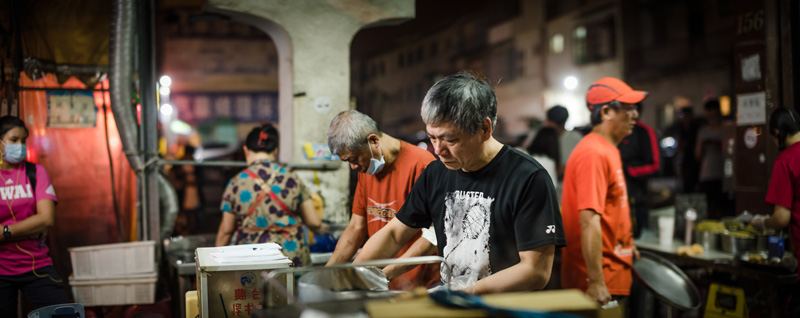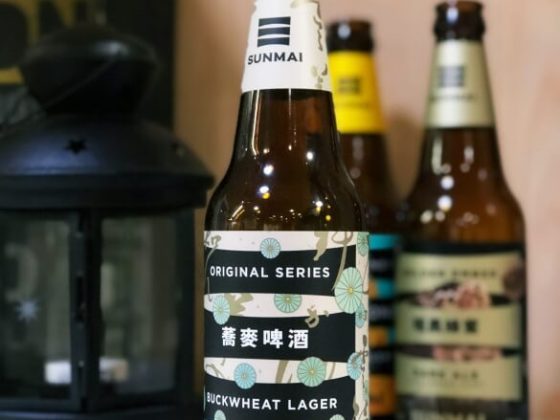Text:
Compared to the cult-like veneration of beef noodles, hot pot, and stinky tofu in Taiwan, the guabao (割包 or 刈包) is an underappreciated snack. What English-speakers often call “the Taiwanese hamburger” is available in every town and city, but certainly not on every street, nor even in many night markets.
Because of their shape, these hearty delights often appear in weiya (尾牙) banquets, traditional end-of-the-year feasts at which Taiwanese bosses treat their employees. According to some, a generously proportioned guabaobears an auspicious resemblance to a purse overflowing with money. The way in which the bun envelops the pork has also inspired a nickname which some vendors have embraced: hu yao zhu (虎咬豬, pronounced ho ka ti in Holo, “tiger bites pig”).
Some foodies steer clear of guabao because they think neither of the main ingredients – pork belly and steamed bread – is especially healthful. The meat, while exceptionally tender and juicy, is heavily marbled with fat. To people who believe whole-wheat bread is better for you than loaves made of bleached flour, the shiny whiteness of the wrap suggests it offers nothing but carbohydrates. Those who abstain may be right, yet over the past six or seven years the popularity of guabao in the Western world has leapfrogged that of other Taiwanese dishes.
“The fatty layers and pork rind are still intact but [have] developed an almost gelatin-like consistency. Wobbly collagen-packed meat with a plenitude of flavors”
And truly Taiwanese it seems to be, too. There is a theory, though not a widely held one, that a meat-filled, steamed cut bun called roujia mo (肉夾饃, literally “meat pressed into a small loaf”) popular in the mainland Chinese province of Shaanxi made its way to Fujian and eventually to Taiwan. Fujianese cuisine does have something called khong bah pau (the Holo pronunciation of 焢肉包; kong rou bao in Mandarin), but nothing is added to the meat and bun but celtuce (also known as Chinese lettuce).
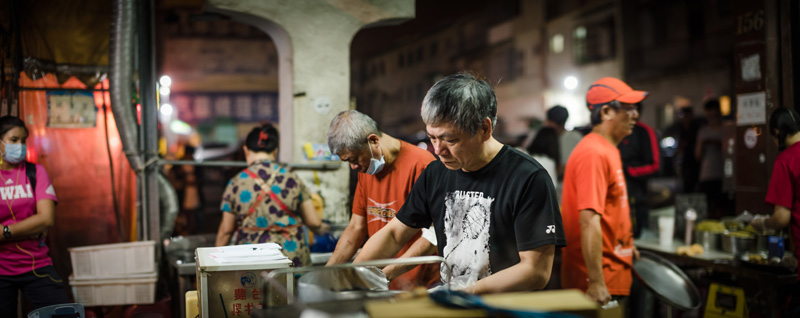
Taiwanese guabao, by contrast, almost always incorporate fresh cilantro, pickled mustard greens, and a dusting of crushed peanut. “These three components extend the dimensions and depth of the dish tremendously, making it so much more interesting,” gush Singaporean bloggers TravellingFoodies. “The regular [khong bah pau] taste rather plain and run-of-the-mill in comparison.”
Just as it is hard to image an American-style hamburger without lettuce, tomato, onion, and perhaps a pickle, many Taiwanese assert that if a guabao is to be considered authentic, peanut powder is an essential element.
Guabao is similar to the Mexican dish carnitas soft taco in that the protein in both is slow-cooked pork. However, whereas carnitas is pulled apart by hand or shredded, most guabao feature a single slab of deliciously soft meat about the size of a deck of playing cards.
Taiwanese usually call this kong rou (焢肉, khong bah in Holo). Beyond Taiwan and Fujian, common names for pork cooked this way include hongshao rou (紅燒肉, “braised pork”) or dongpo rou (東坡肉, featured in many cookery books as “Dongpo pork”). A few vendors advertise their guabao with the Holo term for uncooked pork belly (三層肉, sa chan bah; in Mandarin this cut is known as wuhua rou, 五花肉).
Not just any chunk of pork belly will do. The meat should not be too lean, to ensure it does not become dry and fibrous after braising. The meat is cooked in a thick gravy that typically includes soy sauce, rice wine, and often sugar (see the recipe at the end of this article). Some chefs cook the pork this way for several hours; others not nearly so long. The goal is “melt-in-the-mouth textures,” according to TravellingFoodies. “The fatty layers and pork rind are still intact but [have] developed an almost gelatin-like consistency. Wobbly collagen-packed meat with a plenitude of flavors in savory, sweetness and spice.” (Read more: 8 Taiwanese foods that you don’t even know you need to try (yet)!)
Going international
New Yorkers have embraced the guabao iterations brought to them by restaurateurs such as David Chang and Eddie Huang. Best known these days for writing the memoir on which the ABC comedy Fresh off the Boat is based, Huang founded Baohaus with his brother Evan in 2009.
“The guabao was introduced to American cuisine as a starter in a fine-dining context,”
Stanford Chiou, an American foodie of Taiwanese descent who has sampled guabao throughout the United States and Taiwan, rates the pork-belly buns at Baohaus quite highly. At the same time, Chiou says he understands why some Taiwanese people are unhappy that Huang chose to call the pork-belly version he sells the Chairman Bao, in apparent homage to the late Communist dictator. Baohaus also sells buns filled with fried chicken, fried fish, or fried tofu.
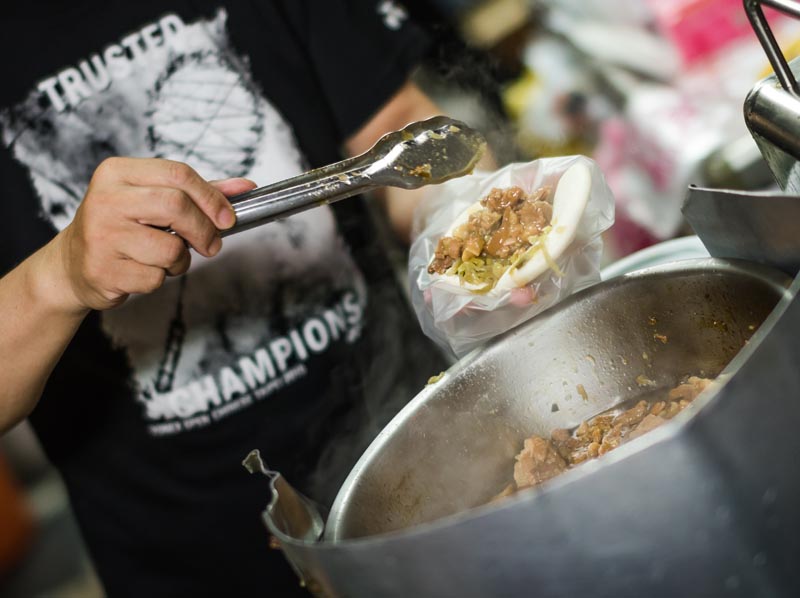
“In New York City, Taipei Hong (in Flushing, Queens) is as close as you’re going to get to Lan Jia in Taipei,” says Chiou. “The khong bah could be better prepared, but you can specify how fatty or lean you prefer the meat, just like at Lan Jia.”
Chiou is referring to Lan Jia Guabao (藍家割包; No. 3, Alley 8, Lane 316, Roosevelt Road, Section 3; open 11 a.m. to 12 midnight, Tuesday to Sunday). It is perhaps Taiwan’s best-known seller of guabao, so expect a queue. The chefs here break with tradition by shredding the pork after it has been braised.
The pork buns popularized by David Chang at Momofuku in New York differ substantially from traditional guabao, says Chiou. “Tiger-bites-pig is filled with braised pork belly, pickled mustard greens, peanut powder, and cilantro, whereas a Momofuku bun is filled with roast pork belly, quick-cured cucumber, scallion, and hoisin sauce,” he notes.
Chiou notes that when a dish is introduced into the American diet from elsewhere, and especially if it becomes popular, “it often ends up being served in portions much larger than the original. Bagels are a good example of this.” Curiously, “the opposite seems to have happened with guabao in the U.S.,” observes Chiou. “I would surmise that this is because the guabao was introduced to American cuisine as a starter in a fine-dining context, where diners are willing to pay higher prices for a relatively small amount of food, as opposed to a context of ‘cheap ethnic eats,’ where there’s an expectation of value for money.”
Across the Atlantic, guabao are not much bigger than scones, and also served in circumstances quite at odds with their humble origins. “We started as a small stall in Netil Market in East London selling just the bao buns and received an amazing response,” says Wai Ting Chung, one of the founders of Bao, which in May 2015 was described by The Daily Telegraph as a “buzzy Taiwanese restaurant” where diners have to queue for a table.
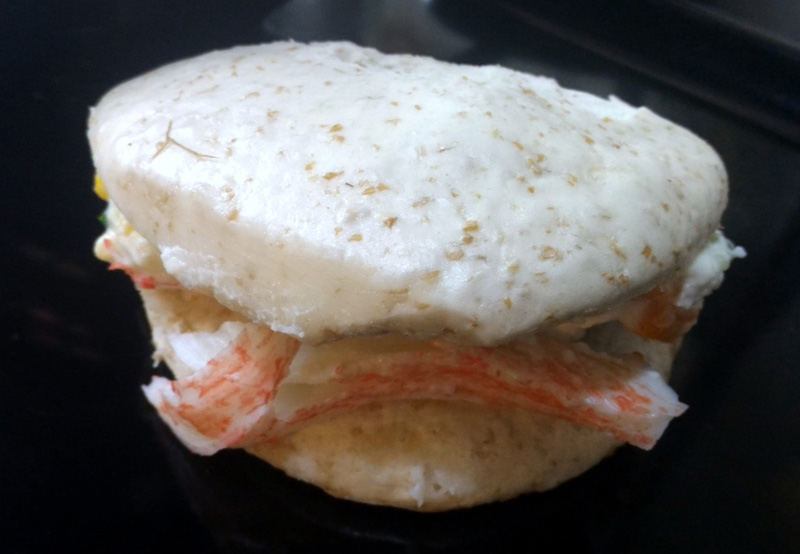
“We never thought that we would have the chance to open up a restaurant, but one thing led to another,” she says. “A year later we opened up in Soho and just a few months ago we opened our newest site in Fitzrovia. The three of us – me, my brother Shing, and his partner Erchen, who was born in Taipei – spent quite a bit of time traveling around Taiwan and eating everything we could along the way. We loved the guabao, and at that time it was quite rare to see a homemade bao in London. We thought it’d be a good opportunity for us to cook something we loved in a city that’s very open to trying new things.”
Chung says that getting the buns just right took a lot of time: “In the UK, the ingredients, temperature, and humidity are so different from Taiwan, so it was important to just keep tweaking the recipe and technique until it was right. In Taiwan, a lot of guabao vendors don’t actually make the bao themselves. They buy them in, whereas baozi (包子) are commonly made fresh, and you can see a big difference. It was important to recreate the softest and fluffiest texture we could.”
“We loved the guabao, and at that time it was quite rare to see a homemade bao in London. We thought it’d be a good opportunity”
Chen Hsin-hung, who sells guabao for NT$40 each in Tainan’s East District, says profit margins are low, but unlike the other items he sells for breakfast, much of the preparation can be done the night before, and the leftovers have a long shelf-life.
Inevitably, prices are higher in Taipei. Ah-Wan’s (阿萬油飯刈包; opposite the Wanhua Railway Station on Bangka Boulevard; open 6 a.m. to 2:30 p.m., Monday to Saturday) charges NT$50 per bun. This eatery has no pretentions – customers sit on stools placed around folding tables – but the guabao are excellent, although the crushed peanut sprinkled over the pork may be too sugary for some people.
Stone Master (石家刈包; flagship outlet at 21-2 Tonghua Street; open 10 a.m. to 12 midnight daily) offers a dozen different fillings, as well as the choice of “original” or whole-wheat bun (NT$55 to $65). However, some of the more exotic options, such as crab meat with salad, are a little bland.
The flagship store of the Olympia bakery/grocery chain (世運食品; 101 BoAi Road, Taipei; open 8:30 a.m. to 10 p.m. daily) sells a top-notch guabao for NT$80. The bun is not overloaded with peanut powder, and the meat is not overly fatty. What makes it truly special is the addition of a slice of braised egg and a sliver of taro tucked under the pork.
Given the growing popularity of guabao in the West, it is not surprising to hear Ivy Chen, who teaches Taiwanese and Chinese cooking to foreigners in Taipei, say that it tends to be her Western students, not those from Japan or other parts of Asia, who ask her to teach them how to make guabao.
“The most difficult part of making guabao is the bun, and my Western students tend to do this better than my Asian students, because they’ve experience making pies or bread. Their kneading and rolling techniques are better,” she says. “I never suggest to my students they buy the buns from a shop instead of making their own, as guabao buns are actually easier to prepare than baozi. Also, not everyone lives near an Asian supermarket, and if they learn this skill, they can apply it to other recipes.”
Recipe for Guabao
(courtesy of Ivy Chen)
Ingredients for 8 steamed buns:
- 300g plain sifted flour
- ½ tablespoon active dry yeast
- 1 tablespoon sugar
- Pinch of salt
- 150ml water
- 1 tablespoon vegetable oil (more oil is need for brushing the cut buns)
Ingredients for braised pork slices:
- 600g pork belly, sliced 1.5cm thick and 8cm wide
- ⅓ cup soy sauce
- 2 tablespoons rice wine
- 1½ tablespoons sugar
- 3 cups water
- 2 pieces of star anise or dried mandarin skin
- 1 stick of cinnamon (optional)
Ingredients for pickled mustard greens:
- 1 stalk of pickled mustard green, finely chopped
- 1 garlic, chopped
- 2 tablespoons soy sauce
- 1 tablespoon sugar
Garnish:
- ½ cup sugared ground peanut (some people may prefer sugar-free ground peanut, but sugared ground peanut is more authentic)
- 2 stalks cilantro (coriander), chopped
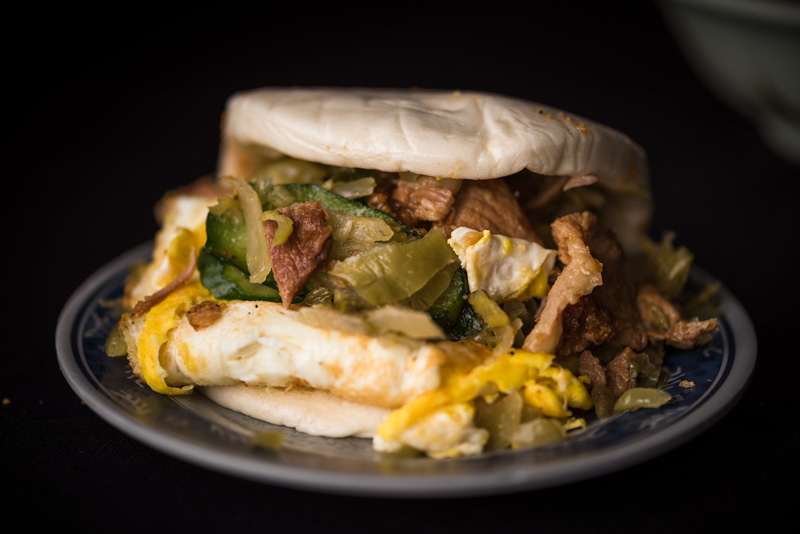
How to make the buns:
Dissolve dry yeast in tepid water for 3-4 minutes. Mix flour with sugar, salt and oil in a large bowl. Leave a hole in the middle, then pour in the yeast water. Bring together the flour and knead the mixture into a dough. Cover with wet cloth, and allow to rest until it has doubled in size (takes roughly 40-60 minutes, depending on room temperature). Divide the dough equally into 8 portions. Roll into balls, then flatten into neat ovals at 7-8mm thick. Lightly grease half of one side of each oval with oil. Fold each over itself with the greased side inside. Line the base of steam baskets with wax paper or lightly greased baking paper, then position the buns in the baskets. Let the buns rest in a warm place for no more than 30 minutes until the buns rise another 50%.
Add 8-10cm water inside a pot or pan and set the steam baskets over it. Turn up the heat and bring water to a boil so you can see steam emerge from the baskets. Steam the buns for another 12-13 minutes. Then keep the baskets over the pan for another 2-3 minutes before removing.
How to braise the pork:
Simmer the pork in water for 5 minutes, then remove and rinse. Mix in all the spices and ingredients, simmer for 40 minutes until the meat is tender.
Separately, sauté the garlic in 2 tablespoons of hot oil, then add the mustard greens for 1 minute over low heat. Add soy sauce and sugar, and water if necessary. Stir fry at low to medium heat for 8-10 minutes.
Assemble the buns by topping the pork belly with pickled mustard greens, peanut powder, and cilantro. (Read More:Wheat Free Snacks and Gluten Free Night Market Fare)
This article was originally published by Taiwan Business TOPICS
Craving for guabao? Join MyTaiwanTour’s Taipei Culinary Experience now!

